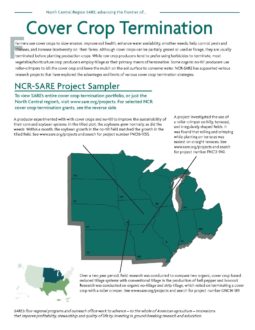Farmers use cover crops to slow erosion, improve soil health, enhance water availability, smother weeds, help control pests and diseases, and increase biodiversity on their farms. Although cover crops can be partially grazed or used as forage, they are usually terminated before planting production crops. While row crop producers tend to prefer using herbicides to terminate, most vegetable/horticulture crop producers employ tillage as their primary means of termination. Some organic no-till producers use roller-crimpers to kill the cover crop and leave the mulch on the soil surface to conserve water. NCR-SARE has supported various research projects that have explored the advantages and limits of various cover crop termination strategies.
This material is based upon work that is supported by the National Institute of Food and Agriculture, U.S. Department of Agriculture through the Sustainable Agriculture Research and Education (SARE) program. Any opinions, findings, conclusions, or recommendations expressed in this publication are those of the author(s) and should not be construed to represent any official USDA or U.S. Government determination or policy.
